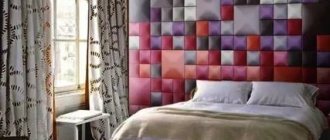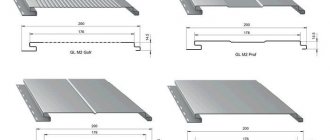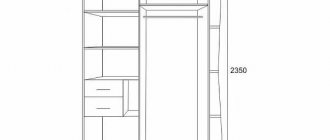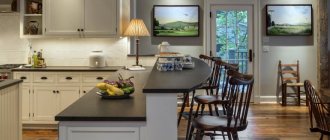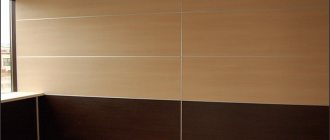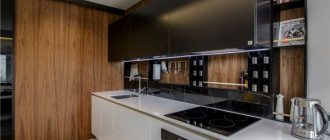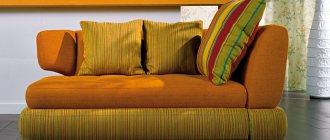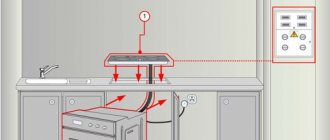What is it and what does it consist of?
MDF is a medium density fibreboard. The two most common forms of material are panels and sheets. Quality and service life do not depend on the shape.
It is made from small sawdust, just like chipboard. But in the case of MDF, smaller sawdust is used, which allows you to create a more dense and reliable structure. Correct slabs are smooth, even and uniform, so they are easy to work with - veneering, processing and milling.
The holes are made without problems, and without crumbs and shavings. You can even apply a complex pattern. In its behavior, MDF is similar to wood, but has a more affordable price.
The material is not afraid of water and can withstand up to 80% humidity, so it is often used in the kitchen or even in the bathroom. Note that real wood can only withstand 60% humidity.
Although MDF can be called a very durable material, it is also flexible. It produces round objects without any problems. The photo shows the panel in section:
What does this abbreviation mean?
It is simply impossible to decipher the abbreviation in Russian, since the name was simply taken and copied from English - MDF, or Medium Density Fiberboard, which translates as medium density fiber board. If desired, you can add a small clarification: wood fiber.
There is no fundamental difference in which decoding to use - it’s a matter of habit. But since the very appearance of MDF took place in 1966 in the USA, therefore the English name is preferred. This building material reached Russia only 31 years later, namely in 1997.
At the moment, the People's Republic of China is considered the leader in MDF production.
Production technology
Modern production makes it possible to create an almost identical copy of the natural structure of wood. The finely dispersed fraction of wood has its own operating characteristics, due to which it has many advantages. But let's start with the stages of MDF production :
- Preparation . The logs are cleared of bark, crushed into chips and sorted, clearing them of debris and dirt. Heat by steam.
- Formation of fibers. The resulting chips are crushed as much as possible in a special machine - a refiner. This is necessary to release the natural resin from MDF - lingin, which will later act as glue.
- Formation of the slab. The prepared mass is sent to the machine, where it is laid in the form of a sheet using rollers. This is where pre-compression occurs.
- Pressing. At this stage, the chips finally take on their future shape. After pressing, the material must cool for half an hour. The unsanded sheet is then processed until smooth.
What are the benefits of MDF furniture?
The material is very popular for making furniture, as it has the following parameters:
- resistance to temperature and moisture;
- ease;
- ease of installation;
- prevalence;
- strength, resistance to wear and mechanical stress;
- good level of sound insulation;
- resistance to microorganisms;
- ease of care;
- durability;
- reduced flammability;
- low cost.
In addition, MDF panels also look beautiful, so they are often used for design solutions. But there are also negative sides. These include:
- low strength of thin sheets;
- limited choice of textures and colors;
- possible reduction in space due to the installation of a frame under the panels (when covering walls).
Specifications
Due to some of its characteristics, MDF sometimes stands even higher than wood. One of these features is that the slab can be bent at any angle, giving the furniture an unusual shape. A medium-hard board can withstand pressure up to 15 MPa. In addition, fungus and other pests simply will not settle in such material.
There are certain standards that companies must adhere to when making the material. For example, the density level - it should be from 720 to 980 kg/m3. Hence MDF boards are divided into two types :
- LDF - low density board (up to 600 kg/m3);
- HDF - high density board (from 800 kg/m3).
Of course, HDF boards are of higher quality, but they will also cost more.
There are also several types of slabs based on quality.
| Variety | Description |
| I | An excellent choice - homogeneous, smooth products, no chips, scratches, roughness or other defects |
| II | Minor defects are allowed - gouges and scratches up to 2 cm long and up to 0.03 mm deep, small chips on the edges, slight roughness |
| III | Instances with pronounced defects - scratches, damage, chips, roughness. This option is suitable for construction purposes. |
Some designers recommend specifying the emission class. This characteristic is responsible for whether the material will release formaldehyde, and in what quantity. According to GOST there are only two emission classes :
- E1;
- E2.
The first class is allowed even for use in children's premises, since such a panel cannot cause any harm. It is these types of specimens that are most often found in construction stores.
Types of panels
Another important nuance for choosing an MDF panel is its release form . They are distinguished:
- Rack type. It is a very elongated rectangle 2–3 meters high and only 15–25 centimeters wide. Such panels are used for ceilings or walls, so they have a lock. When choosing, you should pay attention to it: the lock must be no shorter than 5 mm - otherwise it can simply break off.
- Tile type. The maximum size of such a panel for a wall is one meter per meter. They can be either square or rectangular. They are most often mounted on a frame or on a hidden fastening system (if available).
- Sheet material . Rarely used in decoration, but useful in making furniture. Although the scope for imagination is not limited.
Dimensions of MDF depending on the manufacturer
Manufacturers of medium-density wood fiber materials produce products in different sizes, which is very important to consider when choosing.
| Manufacturer | Main parameters (mm) | |||||
| Length | Width | Thickness | ||||
| Sheet | Rack and pinion | Sheet | Rack and pinion | Sheet | Rack and pinion | |
| Kronostar | 2800 | 2600 | 2070 | 250 | 10 | 7 |
| 2800 | 2600 | 2070 | 153 | 16 | 8 | |
| Kronospan | 2800 | 2600 | 2070 | 200; 153 | 16; 19 mm and above | 7 |
| 2600 | 200 | 14 | ||||
| 2600 | 325 | 9 | ||||
| HDM | — | 1300 | — | 198 | — | 6 |
| 2600 | ||||||
| Union | — | 2600 | — | 238 | — | 7 |
These are the most popular brands that produce MDF panels of the most popular dimensions.
Classification by finish
After manufacturing, the material has a gray-brown color, so it is problematic to fit it into the interior. The surface can also be refined. We will now look at several ways to do this.
Veneering
The slab is covered with veneer, that is, a thin cut of natural wood. Of course, after this the surface cannot be distinguished from an array, but in addition to this, the quality also increases. The veneer is attached with glue, and experts call this the beautiful word “veneering”.
This method of decoration gives the facades a very realistic look. This is not a cheap pleasure, but the following advantages appear:
- moisture resistance;
- resistance to warping;
- do not dry out.
Fine-line
This finish can be called a subtype of the original veneer. Fine-line is also called eco-veneer, since sections of inexpensive and soft wood, such as poplar, are used.
Thanks to this feature, such a material is much cheaper than “real” veneer, but still perfectly conveys the grain of the wood.
Stone veneer
Another type of veneering. In this case, the thinnest possible cut of natural stone is used - about 1-3 mm. Sometimes polyester resins are used, but they look like natural stone.
This surface is resistant to any conditions, even mechanical tests. The only drawback is the small selection of colors.
Plastic
This type of finishing is most often used in furniture production. The idea is simple: a very thin layer of plastic or acrylic is glued onto an MDF panel. In this case, it is necessary to monitor the quality of edge protection - it can be either plastic or aluminum. Without them, the façade will not last long, since the panels will begin to come off and dirt will accumulate underneath them.
Since plastic is used only as a top layer, the question of which is better—a kitchen made of MDF or plastic—is not even worth asking. They go inseparably. We should only talk about comparing finishing materials for MDF, for example, enamel or plastic, acrylic or veneer.
PVC film
If the chosen surface is not a flat one, but one with a pattern, then the slab is first milled and then covered with a film under pressure so that the latter fits into all the recesses of the pattern. This type of panel is also called laminated.
The film can imitate a wood structure, repels dust and increases the panel's resistance to mechanical stress. The surface can be either matte or glossy of any shade.
The main advantages of film MDF include:
- strength;
- resistance to moisture and ultraviolet radiation;
- hygiene;
- Possibility of chemical care;
- Dirt resistance.
High gloss film
The essence of high-gloss film is that it is applied seamlessly - simultaneously to the front facade and side edges. Due to this application, the furniture turns out to be very beautiful, smooth, even and shiny. This service is not yet so popular, so the choice of colors for furniture is limited.
Coloring
After painting, the slab becomes more protected and acquires a pleasant shine. Painting can be either automatic or manual. Enamel, UV varnish or other flexible paint options are suitable. This coating is not as stable as previous analogues, but still protects against previous factors.
The same cannot be said about special enamel paint. It is applied in several thin layers and even protects from mechanical stress. It is also not afraid of moisture and pollution.
But there is one peculiarity - such a coating should never be rubbed with hard sponges: noticeable scratches will remain. Such kitchens most often have a strong gloss. Matte options are more expensive as they require additional processing. But it is easier to care for such a coating.
We recommend reading: Which kitchen is better to choose, glossy or matte?
Soft Touch
One of the varieties of matte finish is Soft Touch. This is a special paint based on rubber varnish. There are no fingerprints or scratches on it, and it does not glare in the sun, creating the impression of a velvet surface. It is very practical to clean, since drops of fat and other dirt are simply not visible.
Classification of MDF panels ↑
For the manufacture of the material, plates of wood fiber boards are used, which can be conveniently adjusted to the size of the surface. It is much easier to choose ready-made MDF wall panels for the kitchen, depending on the area of the cladding.
Based on shape and size, panels can be divided into the following groups:
- Lining or lath - rectangular planks of various widths (150-900 by 2400-4000 mm) with special “locks” along the long sidewalls, used for full or partial covering of walls and ceilings.
Long lining is convenient for finishing large areas
- Tiles are square or rectangular wide panels with a side of 290-950 mm, mainly used for wall cladding or kitchen apron cladding.
MDF wall cladding
Square fragments also look good on the ceiling
- A slab (sheet) is the largest material in area, which is cut according to the parameters required by the customer. Dimensions are selected in the range from 1040 to 2800 mm for the most seamless wall covering.
Installation of MDF sheet panels
In addition, MDF wall panels for the kitchen differ in thickness.
- The thinnest (5-9 mm) are convenient due to their low weight and ease of installation, but cannot boast of sufficient strength, so they are most often used in the manufacture of furniture facades, but can also be used to cover ceilings in the kitchen.
- Medium thickness (10-18 mm) is the main material for wall cladding (as well as the manufacture of doors or furniture frames). They are quite strong, but their thickness will have a slight impact on the usable space of the premises.
- Thick (19-38 mm) are the most durable, mainly used in furniture production, but can also be used for covering large areas that require additional insulation.
And finally, MDF wall panels for the kitchen can be divided according to texture into smooth and textured. A smooth surface (especially with a glossy finish) visually enlarges the room, which is especially important for small kitchens. But on a textured cladding with a pronounced relief, various defects are much less visible, and it looks more unusual and impressive.
Relief finishing materials based on MDF
Slab with a wave-like texture
Interesting! Anyone who wants to practice the art of design can try their hand at selecting combinations of different colors or textures, as well as non-standard (for example, diagonal) installation of MDF boards. If you are not confident in your skills, use ready-made offers with original design, for example, materials with a 3D effect.
Optical illusions using 3D technologies
Comparison with chipboard/chipboard
Chipboard is also made from wood chips. To glue it and give it the desired shape, resins are used, which do not always meet environmental requirements, so such furniture is undesirable for use in the kitchen, although it is very popular.
Due to such differences in the production process, chipboards are not as dense: a maximum of 650 kg/m3, which means they are more susceptible to the effects of water and steam, and are not so durable in general.
For example, when wet, a chipboard board actively absorbs moisture and can increase in volume by about 30%. In this case, we can distinguish laminated chipboard - that is, ordinary chipboard, which is covered with a film on top, or laminated. This material is not afraid of moisture due to the protective top layer, so it is often used to create budget countertops.
But you should understand that if the top layer deteriorates or is damaged, the chipboard will immediately reveal all its shortcomings.
We wrote about what is better for the kitchen - MDF or chipboard >>>
MDF has the following advantages over chipboard:
- with equal thickness, MDF will be twice as strong;
- the ability to form reliefs of any complexity;
- easier to process;
- smoother surface;
- more environmentally friendly;
- not demanding on operating temperature.
But most kitchen furniture, including facades and countertops, are now made of chipboard. Such a set will not last long - about 10-15 years. But thanks to the low cost, this can be even more profitable than one set from an array for 40 years. If environmental friendliness is important, then it is better to choose MDF panels.
MDF or chipboard, which is better? Advantages and disadvantages…
Options for covering a kitchen with MDF panels ↑
If you decide to use MDF panels when decorating your kitchen, it is important to determine the area of their coverage. Actually, there are two options - complete cladding of all surfaces (which is quite rare) or fragmentary cladding of walls, ceilings or sections thereof. We propose to consider several areas in which this material will serve as both functional protection and an effective interior decoration.
Full cladding - pros and cons ↑
At first glance, it seems that the best option for finishing a kitchen with MDF panels is to completely replace all facing materials with decorative wooden plates. But the result obtained rarely lives up to expectations. To implement this idea, you will need a really spacious room with a high ceiling, otherwise a small kitchen with such decor can turn into something like a wooden box.
Of course, you can use your imagination and try to create original color combinations, play with the texture of embossed and smooth materials, or perform installation with non-standard installation. For example, choose square slabs for the floor, multi-colored lining for the walls, and line the ceiling with seamless panels. But it’s still better to leave this option for the kitchen at the dacha or in a country house.
Full kitchen refurbishment in spacious home
MDF cladding of walls, floors and ceilings
For kitchens in apartments, partial finishing with MDF panels is often used. This can be the cladding of the lower part of the walls, used mainly in large rooms, since in small kitchens this space is almost completely covered with furniture. You can also cover the ceiling with MDF lining or sheeting. Moreover, if finishing with wood slabs is more recommended for the walls, the ceiling covering should be chosen in light neutral shades - white, soft blue, creamy. In addition to plain panels for the ceiling, imitation stone, such as light marble, and original reliefs are suitable.
Finishing MDF walls and ceiling in the kitchen
Kitchen with MDF wall finishing
Modern kitchens with MDF wall finishing
Important! You should not choose the same material for covering the walls and ceiling - let the panels differ in texture or color so as not to visually reduce the volume and height of the room.
Dining area lining ↑
The beautiful structure and warm color of natural wood create an atmosphere of home comfort, which is why veneered or laminated MDF is often used to decorate the dining area - the part of the kitchen where the whole family gathers around the common table. This cladding looks much cozier than tiles and is much more practical than wallpaper. And since the dining area is located some distance from the stove and sink, the impact of excess moisture or temperature on the finish is minimal.
Advice! If you use finishes of different colors, textures or shapes, you can visually differentiate the working and dining areas of the kitchen.
Highlighting the dining area with wood finishes
A cozy duet - a massive tabletop and a wall with wooden trim
If the kitchen is spacious enough, has a long rectangular shape, or is combined with another room in the house, you can install a small partition, separating the dining room and work area not only visually. And this is where seamless wall sheets made of MDF that imitate wood will come in very handy. Moreover, veneer made from expensive species, a simple varnish coating, or material with realistic photo printing can be used for this. Air partitions made of MDF made by laser cutting look no less impressive.
Openwork partitions for zoning kitchen space:
On a note! In kitchens with a small area (for example, in Khrushchev-era apartments), this material is used to decorate the wall opposite the working one. Moreover, for this it is not even necessary to completely sheathe the entire area; it is enough to cover the surfaces free of furniture with MDF panels. Particularly good for partial cladding is a seamless sheet cut to fit the open space.
Application of MDF for a kitchen apron ↑
The section of the wall between the upper and lower cabinets of the kitchen unit belongs to the working area, that is, it is here that the exposure to moisture and temperature is the highest. Therefore, MDF panels for finishing should be selected only with good protection (and ideally, moisture resistant) or additionally covered with a glass screen.
The most reliable option for wall panels for interior decoration of the kitchen are the so-called MDF skins with a heat-resistant plastic coating. By the way, another advantage of these sheet slabs is their rich decorative assortment, including photo printing. For inspiration, we offer a selection of photos of wall panels on a kitchen apron.
With plastic coating and photo printing:
With a relief pattern - an interesting idea for fragmentary wall decoration:
The choice of finish for the apron should take into account the interior style of the room, the color scheme and the design of the kitchen facades. These can be monochrome panels of any shade, coverings with a pattern, photo print, imitation of fabric, stone, brick. MDF panels with a beautiful wood structure look the most impressive and natural.
Wooden apron for the work area:
On a note! It is better to mount the wall panels for the apron on the sheathing in order to run wiring underneath them to illuminate the work area and communications for connecting various household appliances.
Comparison with natural wood
Even over natural wood, MDF has advantages:
- equal density over the entire surface of the slab;
- absence of natural defects - for example, knots, voids, etc.;
- possibility of embossing and other special processing;
- resistance to microorganisms and fungi;
- the cost is 60–70% lower.
Solid wood furniture belongs to the expensive and elite category. Russian oak is valued more than others - it is also used for veneer.
The most budget option is birch or pine. Such a set will last 40 years or even more - the main thing is that you don’t get tired of it. But no matter how beautiful and prestigious such furniture may look, it is very sensitive to temperature changes and is also difficult to maintain. For these reasons, the array is now being replaced with veneered MDF.
Comparison with plywood
MDF also has advantages over plywood:
- absence of external and internal defects such as knots and holes from them, veneer overlaps, cracks, and so on;
- perfectly flat and smooth surface;
- no deviations in the width or length of the sheet;
- not afraid of exposure to steam;
- more favorable price.
But at the same time, plywood is more durable. This is due to the manufacturing process: solid wood is used for plywood, and only its fibers are used for MDF. It is not customary to use plywood for kitchen furniture or even backsplashes.
Comparison with fiberboard
Fiberboard is a material also made from wood chips. The difference from MDF is the use of synthetic resins to strengthen the wood board.
The plate is made by wet pressing, so its back is not smooth, but resembles a mesh from a brand on cottage cheese. This is not the best option for the kitchen, as dust may accumulate.
To better imagine this material, you need to remember the back wall of some cabinet - that rough material is fiberboard, or, as it is sometimes called, hardboard.
Fiberboard is not afraid of moisture and temperature changes, but at the same time it is also low in cost. But the manufacturing process itself does not allow making hardboard thick, so it cannot be used as a facade or countertop in the kitchen. The maximum is the back wall of the kitchen unit.
Advantages of the material
In addition to their natural composition, MDF panels have many characteristics that are valuable for use in finishing kitchen spaces exposed to moisture, temperature, fats and other contaminants:
- Moisture resistance . The denser fiber structure, unlike chipboard, allows moisture to pass through to a much lesser extent, which allows you to maintain the quality of the panel itself for a long time.
- Resistant to direct sunlight.
- High mechanical strength - protection against possible impacts.
- Wide range of design possibilities. Glossy and matte coating, imitation of stone and wood, photo printing - all this allows the panels to fit into the design of any room.
Note. It is worth noting that the panels, especially their ends, are not so moisture resistant as to withstand prolonged contact with water. Therefore, during installation, special attention should be paid to protecting vulnerable areas using corners and profiles.
A material with such parameters is ideal for decorating a room with high humidity and temperature changes . And you can use it not only to decorate a kitchen apron, but also for the dining area or any other surface.
How to choose and buy panels?
The choice of MDF panel should be based on where it will be used - hence the focus on different characteristics. For example, painted panels are quite suitable for the kitchen, since they have increased resistance to moisture and steam. But this will still not be enough for the bathroom - only laminated materials (LMDF) are suitable here.
If any additional finishing work is planned on the furniture facade, then it is best to select veneered MDF. If it is necessary to decorate large spaces, ordinary tiled MDF will do.
It is important to pay attention to the manufacturer. Of course, as you can see above, the choice of domestic brands is wide, but foreign materials, for example, from Poland, Sweden and Germany, have the best reputation. But copies from China cannot boast of quality - they charge a price.
In any case, before purchasing, it is necessary to conduct a thorough inspection of the selected material for the kitchen:
- check the surface for smoothness and absence of chips;
- there should be no smell;
- the color should be uniform.
Such a thorough check is due to the fact that some unscrupulous manufacturers, under the guise of MDF, sell laminated chipboard panels, which are inferior in quality and strength.
Finishing technology
The design of this kitchen with MDF finishing on one wall is impressive!
The first thing to start with is measuring the area of the walls (working surface). Your financial costs for materials and components depend on the accuracy of measurements. Next, we buy internal corners, MDF panels, special glue for insulation and external corners (glued with liquid nails).
Kitchen walls are finished with MDF panels using the following tools:
- Construction knife;
- Nails;
- Liquid Nails;
- Panel holder;
- Jigsaw (electric jigsaw);
- Hammer.
Attention! Don’t forget about surface preparation: think in advance about the location of sockets, switches and communications, dismantle old tiles and baseboards.
Installing the first panel
Now we will analyze in detail the main stages of work on finishing the kitchen walls with panels.
- Working with insulation. It is customary to use penofol as insulation (sealant). It is slightly thicker than wallpaper and has a foil surface on one side (it is the foil surface that must be pressed against the wall so that the heat does not escape from the room).
- Panel fitting. After you have managed to deal with the insulation, we proceed to such a stage of work as finishing the kitchen walls with MDF panels. We start by cutting the panels, corners and holders to the required size.
- Fasteners The cladding begins to be attached from any corner in the room. But it is necessary to remember that the very first panel should lie with the tenon towards the corner. Holders are inserted into the remaining free groove, and the panel itself is secured to the wall with nails. We fasten the next panel using approximately the same principle, only now the tenon is inserted into the groove of the first panel.
We consistently fix our cladding
- After you have managed to secure all the canvases with your own hands, we close the internal and external corners with special corners. It is also customary to cover the top of the wall with a corner, but the lower part is covered with a brand new plinth (no matter what kind, plastic or wooden).
What can you make with your own hands from MDF?
At home, you can make almost any furniture and decoration from this material (set, table, chairs, apron, ceiling, etc.). The main thing is to have two things:
- good tool;
- skillful hands.
If these two components are found, then it’s just a matter of fantasy and imagination. Some craftsmen make their own kitchen sets from MDF - this results in excellent savings. An example of such amateur activities that can be done is in the photo.
Would you like to repeat something similar? For cutting MDF panels at home, a jigsaw with a suitable blade is best - this work is the easiest and fastest. If you don’t have a jigsaw, you can get by with a saw or even a grinder.
Interesting read: Painting and patination of MDF kitchen facades in 7 steps
conclusions
The sizes of MDF wall panels can be selected depending on the purpose of the purchase. Manufacturers offer a large selection of different sizes, colors and coatings. When choosing sizes, it is necessary to accurately calculate the number of panels and the parameters of each sheet so as to ensure a minimum of waste when installing the panels.
MDF is a material that enjoys well-deserved popularity in domestic construction. Many spectacular design projects owe their originality to this durable and impressive material.
The opportunity to experiment with wall MDF, the dimensions of which are selected individually, is available to everyone.
Care
The performance qualities of MDF are quite high, so furniture or decoration does not require special or complex care. However, to extend service life and maintain a presentable appearance, the following rules should be followed:
- wipe with a clean and damp cloth;
- maintain the temperature at a level of 10 to 40 degrees;
- do not use solutions containing chlorine or acids;
- use soap solution;
- do not scratch, trying to tear something off, for example, with scissors or a knife;
- polish using special wax or silicone based products.
All these rules apply rather to kitchen facades. Caring for other MDF furniture most often comes down to wiping with a dry cloth.
Wall slabs
The use of MDF for wall decoration is justified by a number of positive qualities of this material. They allow you to level the surface without the use of dry mixtures, which saves apartment owners from lengthy, dirty repairs that consume a lot of time and money.
How to use brick-like decorative panels for interior decoration can be found in this article.
The installation of the slabs is carried out using special aluminum profiles attached to the walls parallel to the floor. However, this method “eats” about 5 cm of living space on each side of the room, so if the condition of the walls allows it, you can use the adhesive method of fastening. For this purpose, a certain type of glue is used, which, even after hardening, retains its plastic qualities, which prevents deformation and shrinkage of the slabs. In addition, the structure of the glue must be thick enough to fill uneven walls of varying depths.
PVC panels for the kitchen, photos with drawings and other technical data about the building material can be found and seen from this article.
Dimensions and installation for MDF video wall panels:
The advantage of MDF panels compared to wallpaper that is more familiar to most consumers is the following positive qualities:
- moisture resistance : particle boards are not so afraid of high humidity in the room, which is typical for apartments during the rainy demi-season period;
- easy installation : the lathing only needs to be done once, for the initial installation; If the owners want to change the design of the room, then it is enough to dismantle the old panels and install new ones in their place. This will take an order of magnitude less time than the “dancing with a tambourine” that usually accompanies wallpapering;
- fast and affordable room cleaning : it’s no secret that even on vertical surfaces a huge amount of dust accumulates. The good thing about MDF material is that it allows for wet cleaning - this is a definite plus for people prone to respiratory allergic reactions;
- additional soundproofing of the room;
- the ability to place computer and electrical cables behind the panels;
- environmental friendliness : MDF contains much less toxic substances than chipboard and some types of wallpaper (vinyl, non-woven).
MDF material, what it is and what a building material is, can be found out in this article.
The MDF panel has a groove on one side and a special latch on the other, allowing them to be connected like a lock into a continuous surface with barely noticeable seams.
Leroy Merlin PVC panels for the bathroom will fit perfectly into the interior of the room, which you can find out in more detail in this article.
The disadvantages of the material include the fact that psychologically it becomes obsolete faster than it wears out. In this regard, they are more often used for cladding non-residential premises that are not so often seen - corridors, loggias, bathrooms, kitchens, as well as offices. A plastic corner is used as a “plug” masking the end of the decorative part, the length of which ranges from 1300 to 3600 mm, and the width of the strips is about 56 mm. The size of the HDF sheet also varies within these limits. The color of the corner is selected to match the color of the panel in such a way as to fully match it, but if the design idea requires it, it can, on the contrary, contrast with the general background.
What is the standard type and size
According to their appearance and parameters, wall panels are classified into slats, tiles and sheets. The first resemble long narrow slats, which, after installation is completed, resemble wooden boards attached to the walls, painted in different colors.
You can see what wall panels for a bathroom in Leroy Merlin look like in this article.
The texture of the second is similar to tiles laid in even rows, while the third is sheets with a smooth surface. They have the same technical characteristics, but the difference in shape allows you to visually expand or narrow the room, emphasize the texture of the walls or, conversely, make them inconspicuous. What should the dimensions be? The size of the panels may also depend on the manufacturer.
| Manufacturer | Size, mm | Thickness, mm |
| Kronospan | 2600×200 | 7 or 14 |
| 2600×325 | 9 | |
| 2600×153 | 7 or 8 | |
| HDM | 1300×158 | 6 |
| 2600×198 | 6 | |
| Union | 2600×238 | 7 |
| ProfiLine | 2600×238 | 7 |
| Grenagloss | 2750×1300 | 17 |
| 2800×1300 | 10 | |
| 2440×1220 | 19 | |
| Eco Forest | 2800×2070 | 3, 5, 6, 8, 10, 12, 16, 18, 19, 22, 25, 28, 30, 38. |
When choosing the appropriate size, you should take into account the total area of the room and the pattern of the panel: it should end harmoniously at the floor and ceiling and not cause a feeling of raggedness.
